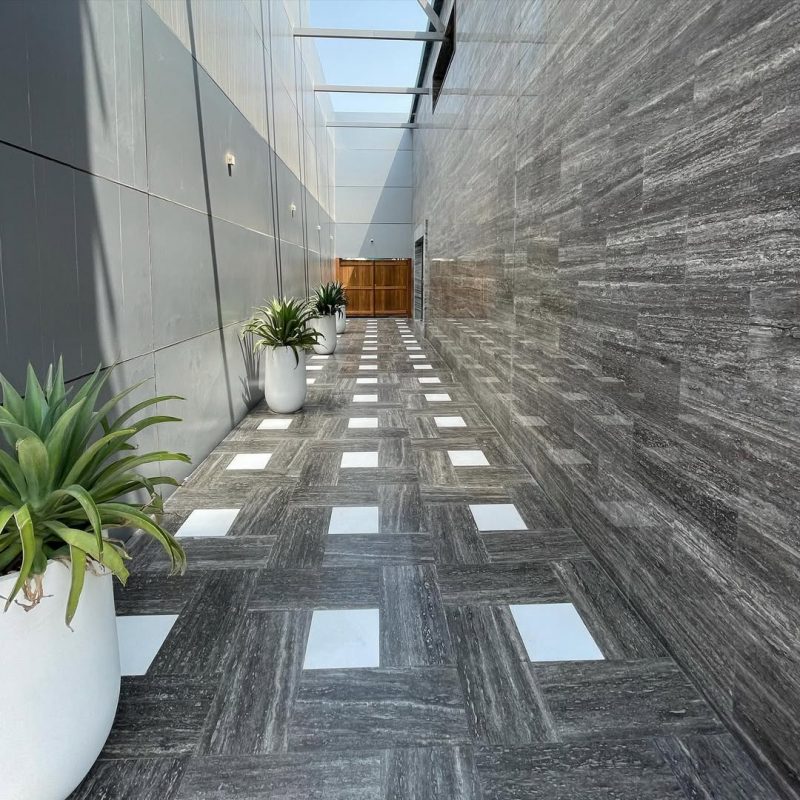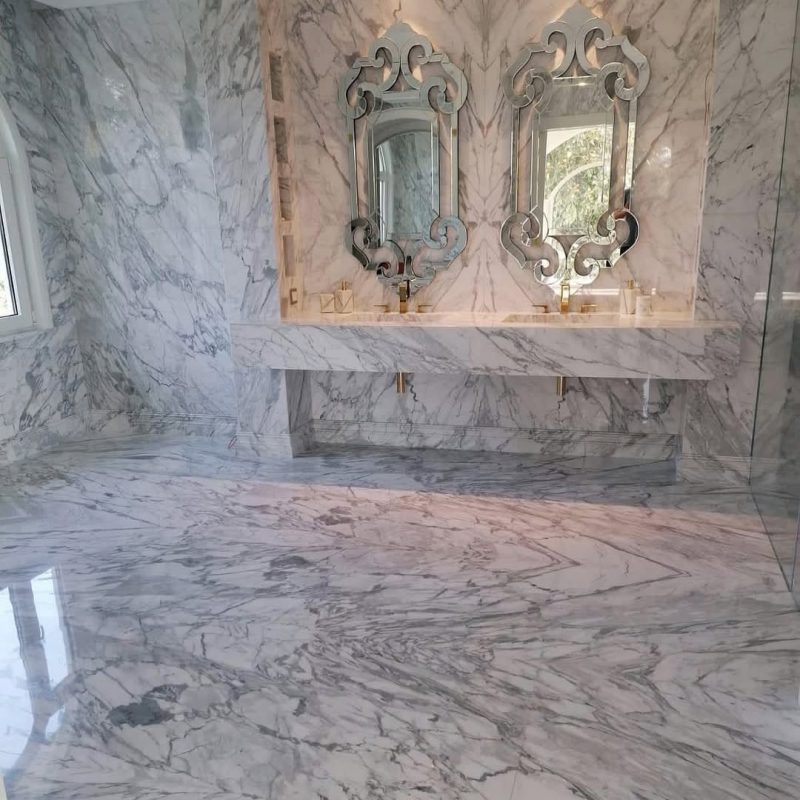In home settings, travertine and marble are two of the most famous types of natural stone. Both materials offer luxury, longevity, and a classic look, but they look very different, require a lot of upkeep, and cost a lot more. By knowing about these differences, you can choose the best stone for your tabletop, floor, or wall covering needs.
What’s the Difference Between Travertine and Marble?
Travertine and marble are limestone-based natural stones created differently. Travertine is rough and porous because it is created from hot spring and cave minerals. Marble looks sharp, thick, and smooth because it is created at high temperatures and pressures.
These variances impact their appearance, maintenance, and lifespan. Travertine appears more natural and rustic than marble, which is used in luxury homes.

Travertine vs. Marble: Which One Is Better?
Your design preferences, intended use, and level of stone maintenance will all influence the decision between travertine and marble.
- Travertine’s warm-toned, textured surface is ideal for achieving a rustic or natural look.
- Marble’s polished finish adds elegance to any room, creating a sleek, opulent feel.
- Marble’s density makes it more wear-resistant in high-traffic areas; however, it requires sealing to prevent stains.
- Travertine is a better choice for outdoor areas because its surface is slip-resistant and stays cool in the sun.
Every material has advantages; thus, selecting the right one will be determined by your personal preferences and practical requirements.
Pros and Cons of Travertine and Marble
Travertine looks softer and more natural than marble and costs less. It keeps feet cool and won’t slide, making it ideal for outdoor usage. But it’s softer and porous, so seal it more regularly. Chips and scratches are more probable.
Marble is durable, glossy, and available in various hues. It may increase your home’s value, but cleaning it is risky and requires sealing to prevent stains. Additionally, it costs more than limestone. Marble suits costly, elegant settings, whereas travertine suits rustic, low-cost ones.
Can Travertine Be Used as a Countertop?
Travertine counters can give a bathroom or kitchen character and warmth. Its porous character, however, calls for regular sealing and careful maintenance to stop stains from spills including coffee, wine, or citrus juices.
Marble or quartz might be a better fit if you want a low-maintenance, more durable countertop. Travertine counters, on the other hand, can be a great addition to any house for those who enjoy rustic appeal and are not bothered about frequent maintenance.

Is Travertine Considered a High-End Material?
Often connected with classic European architecture, travertine gives a high-end impression. Still, generally speaking, it is less expensive than marble. Although premium travertine lacks the opulence of marble, it still gives a house value and elegance.
For those seeking a high-end look without the high-end price tag, its affordability and unusual texture make it a great choice.
Which One Is More Durable: Travertine or Marble?
Though marble is denser and more scratch and wear resistant, both travertine and marble are durable. Being softer, travertine can over time create indentations if not properly cared for.
Marble’s hardness makes it the better choice for high traffic areas including hallways and kitchens. Travertine’s textured surface makes it more appropriate, though, for outdoor areas since it stays cooler under sunlight and is less slippery.
Cost Comparison: Travertine vs. Marble
One very important consideration when choosing between travertine and marble is cost. Usually, Travertine presents a less expensive choice. The quality and finish of the item determine the cost. Furthermore reasonably affordable is the installation. Marble is on the other hand a high-end option. Especially for premium choices, the cost is more. The need for exact cutting drives great expenses in the installation. Marble is a good investment even if its price tag may be higher because of its luxury look and durability. Marble is quite good for those looking for a sophisticated improvement. Travertine is a great alternative if you want a more reasonably priced natural look.
Best Uses for Travertine and Marble in Interior Design
Travertine and marble can add elegance to a house, but they work best in certain locations. Travertine is a fantastic material for outdoor spaces such as patios and pools. This pattern improves the attractiveness of bathroom walls and looks great in rustic-style settings. Marble is an excellent option for kitchen worktops, fireplace surrounds, and fancy bathrooms. This is a wonderful choice for spectacular flooring designs. When picking between these two materials, consider your own style and the stone’s intended position.
How to Maintain Travertine and Marble Surfaces
Travertine and marble need frequent upkeep to appear their best. Both materials need sealing to protect them from stains and moisture. It is recommended to clean them using a pH-neutral cleanser and avoid using acidic substances such as vinegar or lemon juice. Using protective pads beneath furniture and coasters under beverages helps to avoid scratches. Additionally, cleaning spills fast prevents stains from becoming permanent. With proper maintenance, both travertine and marble will remain stylish and durable for many years.
Travertine or Marble: Which One Is Right for Your Home?
Your style, price, and maintenance demands decide the best solution. Travertine is ideal if you want a natural, warm look and regular sealing. Marble is perfect for a polished, refined look if properly maintained. Both materials are beautiful, so choosing one will make your home seem exquisite and last.
